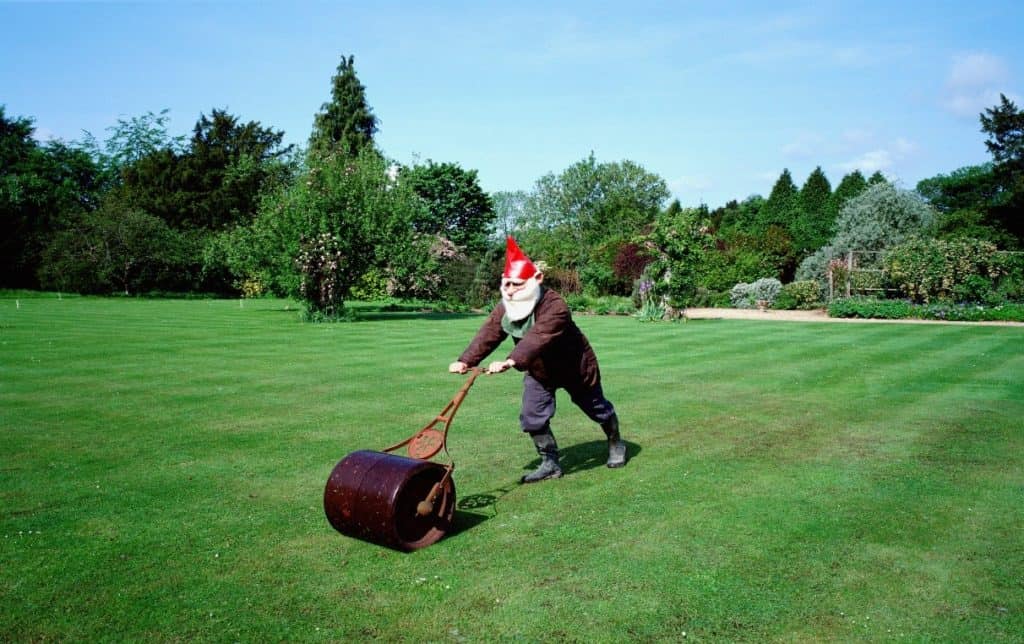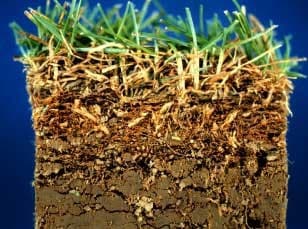Should I Roll My Lawn?
Will Rolling My Lawn Flatten It Out?

Surprisingly, a person rolling a lawn looks very similar to a Gnome rolling a lawn.
From time to time, we will get requests to roll a lawn. Most often people want their lawn rolled because it is uneven and they want to level it out. It does seem to make sense that, when a lawn is lumpy, bumpy or uneven, rolling would flatten out the high spots. Unfortunately, rolling a lawn causes more problems than it solves.
So, Why Shouldn’t I Roll My Lawn?
First, a roller like the one that the Gnome is using will not do much to flatten the high spots. It will only flatten about a half inch of the soil and it doesn’t do anything to fill in the low spots.
What the rolling will do is compact the soil in the vicinity of the root-zone. This is bad for your grass and the root zone.
 Compaction does several things to your lawn – and none are good. A healthy lawn needs air and water to circulate through the soil – and compacted soil reduces this circulation. Compacted soil also makes it harder for roots to grow and spread out in search of water and nutrients.
Compaction does several things to your lawn – and none are good. A healthy lawn needs air and water to circulate through the soil – and compacted soil reduces this circulation. Compacted soil also makes it harder for roots to grow and spread out in search of water and nutrients.
Drainage issues can also arise when water cannot easily soak into the compacted soil. Heavily compacted soil will sometimes create areas of standing water.
Rolling the lawn, especially in the spring when grass is just beginning with lawn recovery after a long winter, can also harm the grass.
Aeration – The Opposite of Compacting a Lawn
Each year we do hundreds of aerations (usually with over-seeding). This process does the opposite of what rolling will do. Aeration is good for a lawn, compaction is bad for a lawn.
Aeration is the process of pulling small plugs of soil out of the lawn which loosens up the lawn. All lawns should be aerated annually.
To fix a bumpy lawn, the best thing to do is to aerate the lawn. The process of aeration will help to create extra space for air, water, and nutrients to filter more easily into the soil. This process not only helps with the overall health of the lawn, but also encourages the bumpy areas in a lawn to even out and settle naturally.
Does it Help to Roll a Lawn after Seeding?
Again, it seems to make sense that rolling your lawn after seeding would help the seed-soil contact (which is important). However, it would be better to take a leaf-rake and lightly rake over the seed to incorporate it into the soil. You do not want to bury the seed – you should still see the seed after raking – the raking will just give the seed more contact with the soil. Rolling over the seed will compact the soil which will make it harder for the new grass roots to grow into the soil.
So don’t be a Gnome!
You now have plenty of reasons to skip the chore of rolling your lawn!
If you are interested in learning more about our lawn rolling service in Reading to Allentown and everywhere in between, please contact us!

Lawn Care
Green Giant Home & Commercial’s Lawn Care services control weeds, build the thickness and density of your lawn and protect it from being damaged by insects and disease, providing you with a great-looking, healthy lawn. We offer fertilization, weed control, liming, insect control, and aeration and overseeding. Visit our Lawn Care page for more information.
Tree Care
Green Giant performs: Proper Diagnosis and Treatment of Tree & Shrub Problems, Insect & Disease Control (including Spotted Lanternfly), and Nutrient Management via Deep Root Fertilization to keep your plants healthy and thriving. Visit our Tree Care page for more information.
Vegetation Management
Green Giant’s Non-Lawn Weed Control services eliminate unwanted vegetation in a wide variety of locations for both residential and large commercial/municipal properties. Areas include fence lines, around obstacles to reduce weed eating, stone/gravel driveways & parking lots, swales, roadside/curbside vegetation management and more. Find more information, visit our Vegetation Management page.
Pest Control
Our full service pest control division provides both Year-Round Service Programs that cover the vast majority of pests that you will encounter and also One-Time Corrective Services for pests such as bees, ants, termites or mice. For more information, visit our Pest Control page.